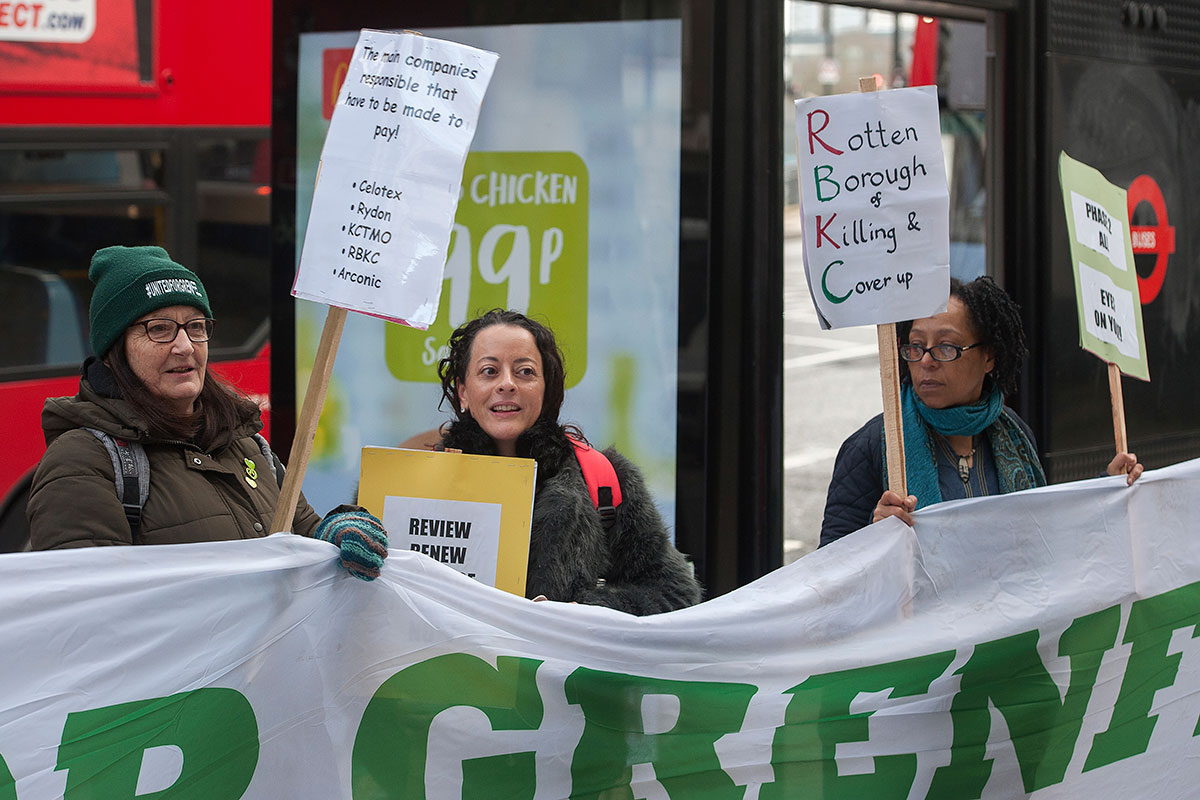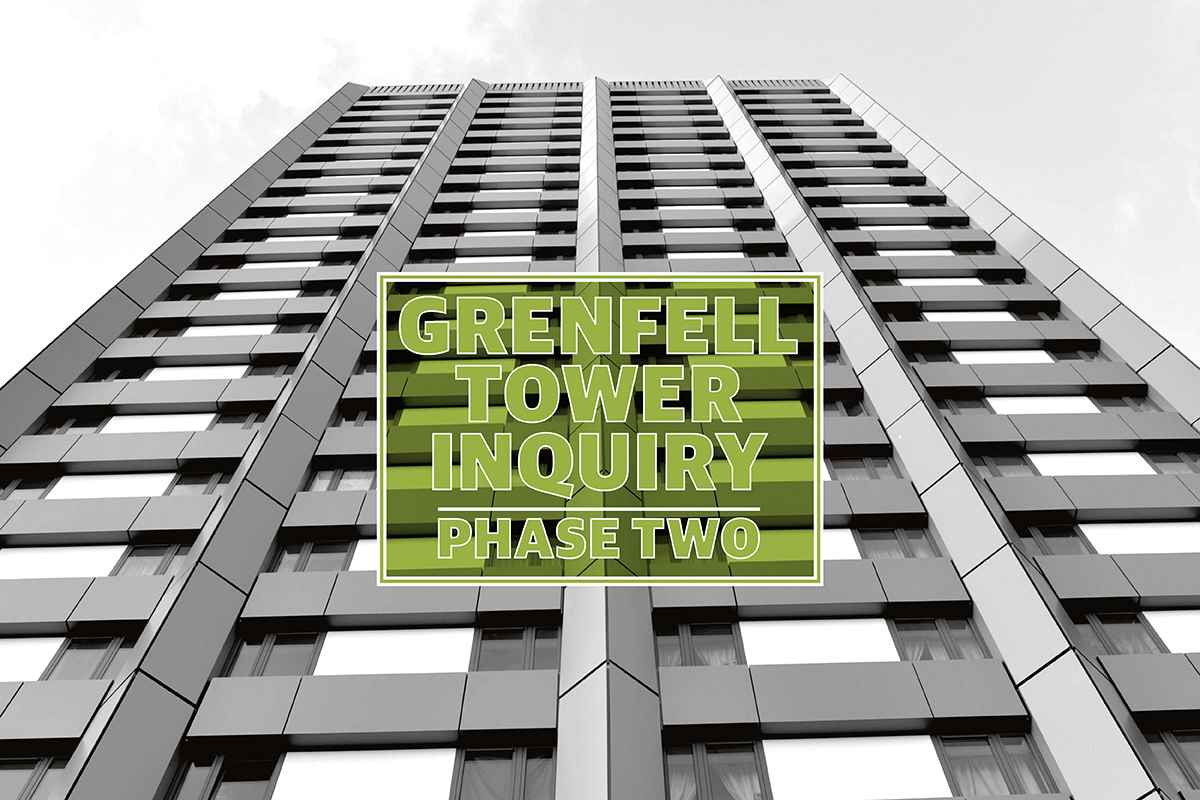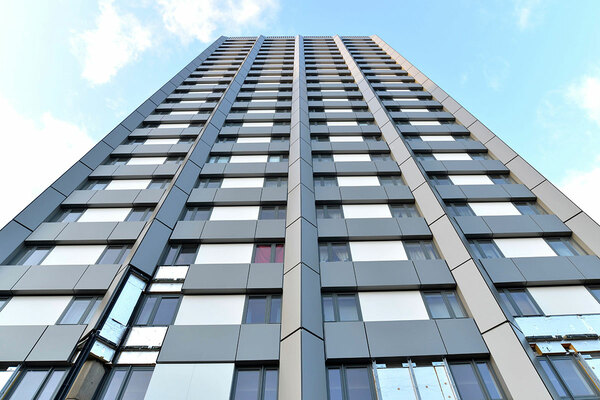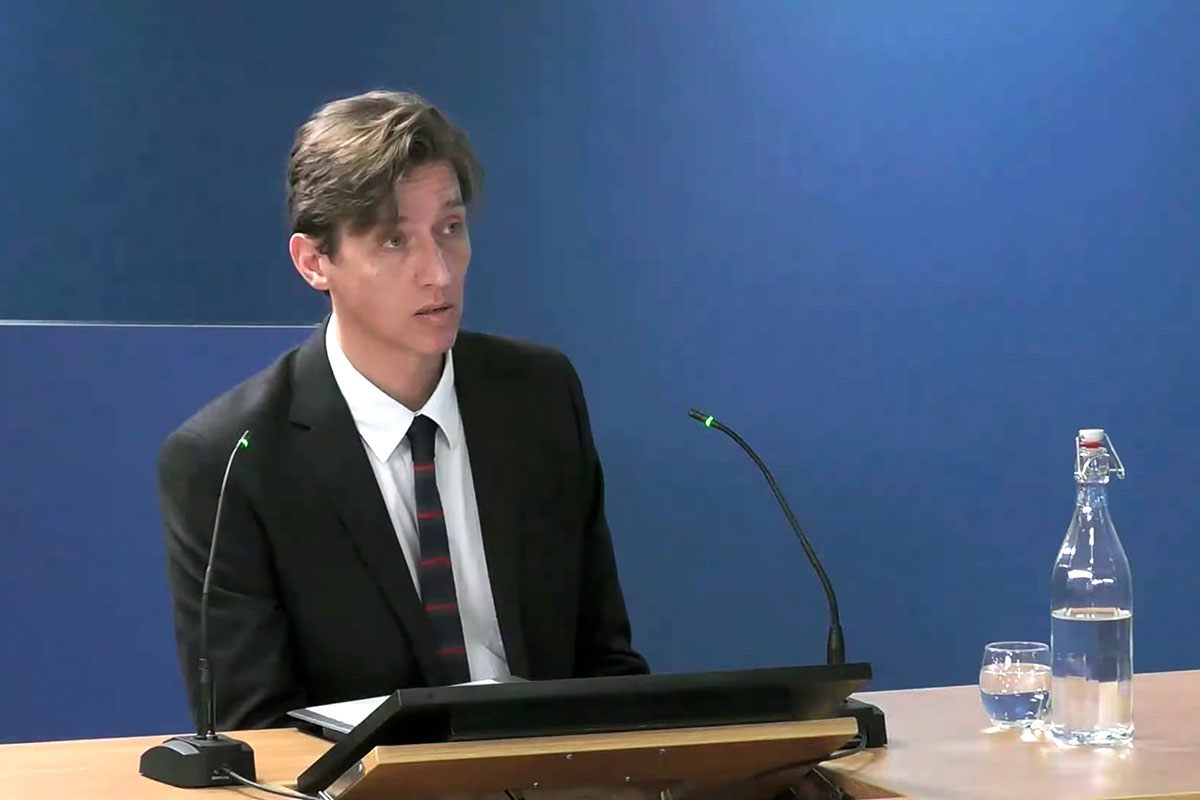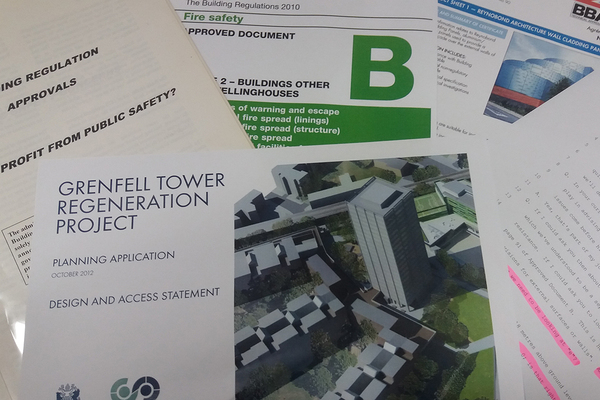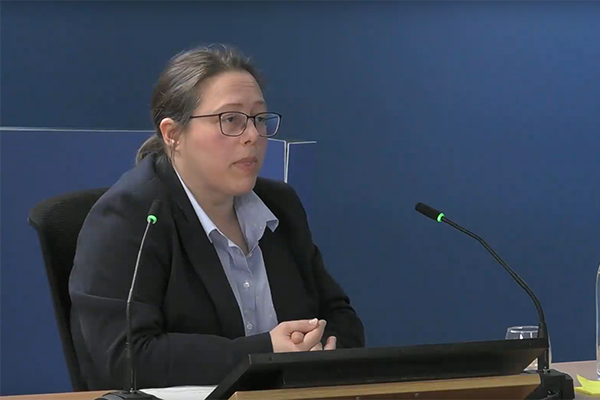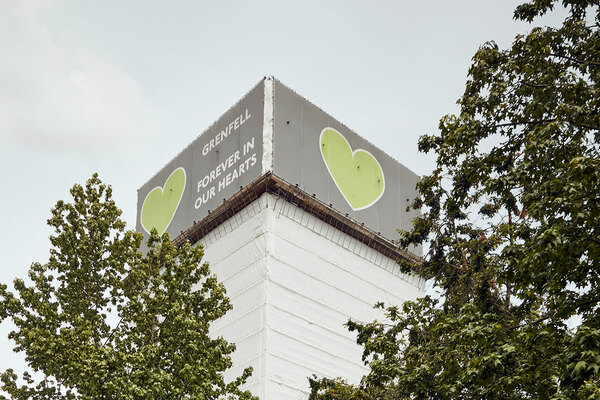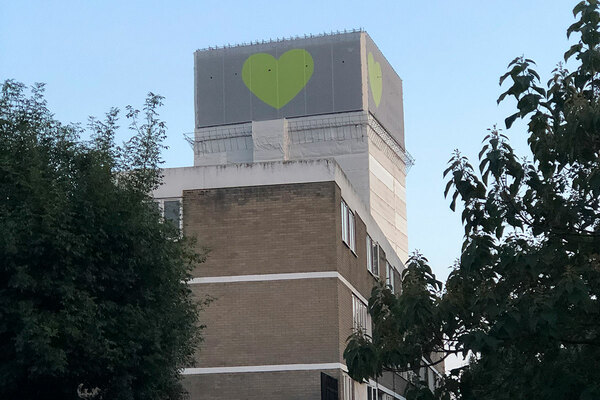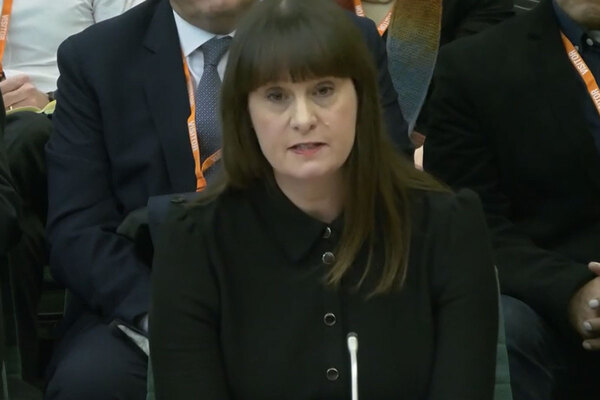You are viewing 1 of your 1 free articles
Grenfell Tower Inquiry phase two: a recap of the evidence so far
Like much of the world, the Grenfell Tower Inquiry is now on hold indefinitely due to the coronavirus outbreak. So, as we pause, Inside Housing recaps the key points from the evidence it has explored so far
The Grenfell Tower Inquiry phase two has been running for nine weeks, but has only heard evidence for four of them.
A lengthy delay to allow the attorney general to consider an application for immunity derailed proceedings after the first week of opening statements, and resulted in a month-long hiatus before the application was granted.
And now, the lockdown of the country due to coronavirus has caused what is likely to be a substantially longer break in proceedings. But in the interim, the inquiry did hear some enlightening evidence. Here are the key points:
Selection of the ACM
Grenfell after the refurbishment (picture: Studio E)
The phase one report identified the polyethylene-cored aluminium composite material (ACM) as the “principle reason” for the devastating external fire spread, and so deciphering how and why this material was selected will be one of the key tasks over the course of phase two.
We have learned a lot already. In 2011, Studio E began to hunt for an attractive “cladding product” for the building. As was known before the inquiry, this hunt eventually led to zinc panels, which were approved in a resident consultation and placed into the specification when the work was tendered in 2013. They were then switched out for ACM. Why did this happen?
As early as 2012, a company called CEP had approached the design team about switching the zinc for cheaper ACM. CEP is one of a small number of approved fabricators that worked closely with Arconic – the firm that sold the panels.
This nudging got stronger in September 2013 when Harley Facades was appointed specialist cladding contractor. Studio E reported to KCTMO that Harley “have been tracking the project for some time”. It added: “Their recurring experience is that budgets force clients to adopt the cheapest cladding option: aluminium composite material (ACM).”
“Their experience is that budgets force clients to adopt the cheapest option”
Tomas Rek, a junior member of the project team at Studio E, sourced options in 2013. He did not ask about fire performance or their fire rating, focusing primarily on cost, aesthetics and the speed with which the material could be delivered. He said there was pressure from KCTMO to specify ACM.
“We are under pressure from the client (KCTMO) regarding the costs with the suggestion flagged of using aluminium,” Studio E wrote in an email to one supplier.
In November 2013, Harley priced the project on the basis of zinc. But it added in an email that from a “selfish point of view” it would prefer to use ACM. When the work was tendered, it listed the zinc panels but included the option for bidders to price up the job using alternatives, including ACM. Mr Crawford then took over on the team and helped oversee the switch to ACM.
We will learn a good deal more about how the product was sold and selected when we hear evidence from KCTMO, Rydon, Harley and Arconic in due course.
Role of the architects
Senior architect Bruce Sounes, who has so far given only partial evidence at the inquiry (picture: Grenfell Tower Inquiry)
Witnesses from architect Studio E have now largely completed their evidence, with the exception of senior architect Bruce Sounes who has twice given partial evidence before being taken ill. The picture that has emerged from the questioning is of a firm that did not have the necessary experience and lacked the knowledge to avoid the terrible mistakes on fire safety.
Studio E appears to have been given the work simply because it was designing a school next door. It had no experience of high-rise refurbishment or overcladding work and its witnesses accepted that they would not have won the job if there had been open tendering. This did not happen because the fee for the work was kept below the £174,000 required to trigger an open competition. Studio E was instead paid an upfront fee of £99,000, with other fees deferred in a move that was designed to avoid a tendering process the firm knew it would lose.
The early work was carried out by Mr Sounes, who pulled together the original design drawings through to 2014. Mr Sounes showed an alarming lack of knowledge of the building regulations and associated guidance. Simply put, he did not think it was his job to ensure the materials being used were safe or compliant with the regulations, trusting specialist cladding sub-contractor Harley Facades to specify compliant materials and building control officers at the council to pull them up if it failed to. Neither happened – and his evidence is that he was not equipped to notice, despite his seniority at Studio E and his role designing the system.
He was replaced in day-to-day control of the refurbishment by Neil Crawford in 2014. Mr Crawford had not completed his ‘stage three’ training and therefore could not officially use the term ‘architect’. Nonetheless, he had come across external facade work and cladding in a previous job.
Studio E witnesses felt “held to ransom”, with Rydon withholding final payment
He too waved through the work. In 2015, he was given a series of drawings by Harley Facades, which he stamped and signed as “approved for construction”. He claimed that this approval related only to “architectural intent” and not safety or compliance with regulations. Studio E witnesses have explained “architectural intent” as little more than “the right aesthetic” and have argued that this was really the extent of their responsibility.
A complicating factor is its contractual position. No contract was ever signed with Kensington and Chelsea Tenant Management Organisation (KCTMO), and it was not until 2016 – with the project almost complete – that a contract was agreed to make Studio E a sub-contractor of Rydon. The witnesses from Studio E – in financial difficulty having undergone a liquidation and rebirth in 2014 from Studio E LLP to Studio E Ltd – felt “held to ransom”, with Rydon withholding final payment until agreement. The contract it eventually signed made it responsible for co-ordinating design work by other contractors and examining drawings for performance.
But by this time, the damage was done.
Government regulations
Picture: Peter Apps
Despite the lack of knowledge or concern for the regulations, they still appear to have been relevant.
First, the presence of a testing route to permit the use of combustible insulation is the door through which Celotex’s marketing material walked. That door was opened in 2006, following lobbying from the insulation industry. If it was not, Celotex would simply never have been able to advertise its product in this way. Second, the presence of a ‘Class 0’ requirement for the external surfaces (and hence cladding materials) appears to have been a big problem. The ACM cladding used on Grenfell had a certificate that at least appeared to confirm it met this rating.
Government had been repeatedly warned – since a select committee investigation into the Garnock Court fire in Irvine, in 1999 – about removing this standard as it was allowing dangerous products through. In his final comments to the hearing, Neil Crawford said: “Unfortunately, the industry only reacts to the regulations that are in place… there was an awareness, as far back as then. Why wasn’t it acted on?”
This remains one of the key questions for another day.
Advertising of the insulation
Picture: Alamy
Alongside the ACM, the cladding system on Grenfell Tower contained Celotex RS5000 insulation, made from a combustible plastic called polyisocyanurate.
We have learned that this material was suggested to KCTMO by engineering consultant Max Fordham as a suitable way to meet the requirements for insulation performance.
The regulatory position when Grenfell was refurbished was that combustible insulation could not be used on a high rise unless it was part of a system that had passed a large-scale test, or (arguably) been signed off by an expert via a desktop study.
Celotex RS5000 had been part of a system that passed a large-scale test in 2014, but this system used non-combustible cement fibre cladding, not solid-petrol ACM.
Celotex was accused of “masquerading horse meat as a beef lasagne”
Celotex’s advertising was unclear about this to say the least, describing the insulation instead as “acceptable for use on buildings above 18m”.
This appears to have been a significant factor in the architects resolving themselves that the product was nothing to worry about.
Neil Crawford, who oversaw the day-to-day refurbishment for Studio E in 2014, spoke particularly strongly – accusing Celotex of “masquerading horse meat as a beef lasagne”.
Some disturbing internal Celotex emails on this point were read out in the first week. In one, a supplier joked about the “smoke and mirrors” involved in the marketing of the insulation and said he would adopt a “caveat emptor [buyer beware]” approach. In others, Celotex’s team appeared to acknowledge that the product could not pass a test in combination with ACM. We will hear from Celotex when the inquiry resumes.
Role of the fire engineers
Cate Cooney gives evidence (picture: Grenfell Tower Inquiry)
Fire engineer Exova’s role was as follows: it was brought in by Studio E in 2012 to produce a fire safety strategy for the building as it stood, and a further one for the refurbishment.
So far we have heard only from Cate Cooney, a senior consultant who produced the report on the building as it stood. Her report – based largely on drawings from the tower’s construction in the 1970s – made a series of assumptions: that the building had been built to a good standard, maintained to the standard it was built and had good compartmentation and smoke detection.
But arguably more important is what was said about the refurbishment. While Exova’s witnesses have not yet been questioned about this, Studio E’s have.
So we know Exova produced two draft strategies for the refurbishment – in October 2012 and October 2013. Both documents said: “It is considered that the proposed changes will have no adverse effect on the building in relation to external fire spread, but this will be confirmed by an analysis in a future issue of this report.”
“Changes will have no adverse effect in relation to external fire spread”
The problem is that when it gave this opinion, Exova’s consultants had the information to be aware that a rainscreen cladding system with combustible insulation was planned.
Exova’s witnesses are likely to argue forcefully that they did not know that the originally planned zinc panels would be switched to the more combustible aluminium composite material. The “future issue of this report” was never commissioned. But Exova will still need to explain why it thought a rainscreen cladding system with combustible insulation did not need to be flagged as a fire risk, or why it did not raise that the insulation breached government guidance. Its failure to do so appears to have given the architects confidence with regard to fire safety.
“From our point of view, at this point… that sentence confirmed to us there was no concern [with regard to the cladding],” Mr Sounes said.
From April 2014, when Rydon was appointed design-and-build contractor, it opted against retaining Exova’s services. But Exova did remain involved – providing responses to queries via email. What it said will be looked at once the inquiry resumes.
The organisations involved in the refurbishment of Grenfell Tower
Picture: Jon Enoch
KCTMO: Kensington and Chelsea Tenant Management Organisation, the arm’s length management organisation responsible for providing housing management to Grenfell Tower. It was the end client which procured the refurbishment and oversaw it.
Rydon: Main contractor. It won a tender for the ‘design and build’ of the refurbishment project in March 2014, with a contract signed in October. It then held overall responsibility for the work, sub-contracting various elements to more specialist firms.
Celotex: The manufacturer of the RS5000 insulation which formed the majority of the insulation on the tower. The product is made from a combustible plastic called RS5000.
Arconic: A large multinational aluminium company, which manufactured and sold the Reynobond PE 55 cladding panels which were installed on the tower.
RBKC: As well as ultimately owning the tower, the Royal Borough of Kensington and Chelsea provided the ‘building control’ function for the refurbishment. This involved providing a completion certificate which effectively signed off the project as compliant with building regulations.
Studio E: Architect – first engaged by KCTMO as the principal designer for the wider refurbishment, it became a sub-contractor following Rydon’s appointment in 2014, working under the standard RIBA terms of business.
Harley: Specialist sub-contractor for the cladding. It was in contract with Studio E before Rydon was appointed, and then struck an agreement with Rydon for the design of the facade works.
Exova Warringtonfire: Fire engineer. Appointed by KCTMO in mid-2012 to provide a fire strategy for the building as it stood and for the refurbishment work. Three versions of the refurbishment version were produced, the last in November 2013. It provided ongoing advice after this point but was not directly engaged by Rydon.
CEP: The fabricator, responsible for cutting the panels into cassettes. CEP was one of a small number of ‘approved’ fabricators which worked closely with Arconic. Also supplied the window frames.
Max Fordham: The engineering consultant which worked for the TMO providing advice on energy strategy and sustainability. It was Max Fordham that identified Celotex insulation as a product which could meet the target insulation performance and was also thin enough to fit the design dimensions.
Kingspan: Produced and sold a smaller amount of combustible K15 insulation which was used on the tower.
Siderise: Produced and sold the cavity barriers.
Aluglaze: Produced and sold the window panels.
Artelia: The construction, design and management co-ordinator, employer’s agent and quantity surveyor, assisting KCTMO with its management of the contract.
Osborne Berry: The building contractor appointed by Harley to fit the cladding and window systems.
Kevin Lamb: An independently outsourced specialist cladding designer which provided Harley with detailed design drawings.
John Rowan and Partners: The clerk of works reporting to the TMO, responsible for site inspection and monitoring.
SD Plastering: A sub-contractor responsible for fitting the window surrounds.
JS Wright: A mechanical and electrical sub-contractor. It will have little involvement in module one.
Curtins Consulting: A structural engineer reporting first to KCTMO and then to Rydon. They will also have little involvement in module one.
Grenfell Tower Inquiry phase two: weekly diaries
Module one: the refurbishment
Week one: A vivid picture of a broken industry
After a week of damning revelations at the opening of phase two of the Grenfell Tower Inquiry, Peter Apps recaps the key points
Click here to read the full story
Week two: What is the significance of the immunity application?
Sir Martin Moore-Bick has written to the attorney general requesting protection for those set to give evidence at the Grenfell Tower Inquiry. Peter Apps explains what the move means
Click here to read the full story
Week three: Architects of misfortune
This week saw the lead architects for the Grenfell Tower refurbishment give evidence to the inquiry. Peter Apps runs through the key points
Click here to read the full story
Week four: ‘I didn’t have any perception that it was the monster it’s become’
The architects continued to give evidence this week, outlining a lack of understanding of the fire risk posed by the cladding materials and its design. Nathaniel Barker reports
Click here to read the full story
Week five: ‘No adverse effect in relation to external fire spread’
As the Grenfell Tower Inquiry returns from its long absence, Peter Apps recaps the key points from a week of important evidence from the fire consultants to the refurbishment
Click here to read the full story
Week six: ‘I can’t recall any instance where I discussed the materials with building control’
Nathaniel Barker summarises what we learned from fire engineers Exova, architects Studio E and the early evidence from contractor Rydon
Click here to read the full story
Week seven: ‘I do not think I have ever worked with a contractor operating with this level of nonchalance’
Two key witnesses from contractor Rydon gave evidence this week. Peter Apps recaps some of the key points from a revealing week of evidence
Click here to read the full story
Week eight: ‘It haunts me that it wasn't challenged’
Four witnesses from contractor Rydon gave evidence this week. Lucie Heath recaps what we learned on the last week of evidence before the inquiry breaks for five weeks
Click here to read the full story
Week nine: ‘All I can say is you will be taken out for a very nice meal very soon’
This week the inquiry heard evidence from witnesses at Harley Facades, the sub-contractor responsible for Grenfell Tower’s cladding. Peter Apps recaps the key points
Click here to read the full story
Week 10: ‘As we all know, ACM will be gone rather quickly in a fire!’
As the Grenfell Tower Inquiry entered its 10th week, Jack Simpson recaps the key points from a week of important evidence from the refurbishment’s cladding contractor
Click here to read the full story
Week 11: ‘Did you get the impression Grenfell Tower was a guinea pig for this insulation?’
With witnesses from the cladding subcontractor, the firm which cut the deadly panels to shape and the clerk of works which inspected the job giving evidence this was week full of revelations. Peter Apps recaps the key points
Click here to read the full story
Week 12: ‘Would you accept that was a serious failing on your part?’
With the surveyor who inspected Grenfell Tower for compliance giving evidence, this was a crucial week from the inquiry. Dominic Brady and Peter Apps report
Click here to read the full story
Week 13: ‘Value for money is to be regarded as the key driver for this project’
With consultants to Kensington & Chelsea Tenant Management Organisation (KCTMO) giving evidence, attention at the Grenfell Tower Inquiry turned for this first time to the actions of the TMO and the council. Peter Apps reports
Click here to read the full story
Week 14: ‘Did it not occur to you at this point that your budget was simply too low?’
This week, for the first time in phase two, the inquiry heard from Kensington & Chelsea Tenant Management Organisation, the landlord that oversaw the fatal refurbishment of Grenfell Tower. Lucie Heath reports
Click here to read the full story
Week 15: ‘Have you ever informed the police that you destroyed documents relevant to their investigation?’
Witnesses from the Kensington and Chelsea Tenant Management Organisation (KCTMO) gave evidence for a second week, which began with a shocking revelation about withheld and destroyed evidence. Peter Apps recaps
Click here to read the full story
Week 16: ‘I conclude this was very serious evidence of professional negligence’
This week saw members of Kensington & Chelsea Tenant Management Organisation finish giving evidence, before the inquiry’s expert witnesses took the stand to make some highly critical assessments of the work they had seen before and during the refurbishment of Grenfell Tower. Jack Simpson recaps
Click here to read the full story
Grenfell Tower: a timeline of the refurbishment
Following the conclusion of module one of the Grenfell Inquiry’s second phase, Peter Apps presents a timeline of the key moments during the fatal refurbishment of the west London tower block
Click here to read the full story
Module two: the cladding products
Week 17: ‘It’s hard to make a note about this because we are not clean’
The start of the second module of the Grenfell Tower Inquiry phase two came with some huge revelations about the companies that sold the products used in the cladding system. Peter Apps reports
Click here to read the full story
Week 18: ‘It was just reckless optimism wasn't it?’
As the inquiry began cross-examining witnesses for the second module of its phase two work, the picture surrounding just how Grenfell Tower ended up wrapped in such dangerous materials became a little clearer. Nathaniel Barker was keeping an eye on proceedings
Click here to read the full story
Week 19: ‘And that was intentional, deliberate, dishonest?’
The Grenfell Tower Inquiry this week heard the shocking story of how the insulation manufacturer “manipulated” official testing and marketed its product “dishonestly”. Peter Apps tells the story
Click here to read the full story
Week 20: ‘We were outed by a consultant who we then had to fabricate a story to’
This week the inquiry investigated the actions of Kingspan – the manufacturer of one of the insulation products used in the tower’s cladding system. Dominic Brady reports
Click here to read the full story
Week 21: ‘It’s there in black and white isn't it? We see a complete absence of any consideration of life safety’
The story of insulation giant Kingspan’s testing and marketing of its combustible insulation for high rises was unpacked in minute detail this week. Peter Apps reports
Click here to read the full story
Week 22: ‘All we do is lie in here’
In the third week of evidence from insulation giant Kingspan, the inquiry continued to uncover shocking details about the firm’s behaviour both before and after the Grenfell Tower fire. Lucie Heath reports
Click here to read the full story
Week 23: ‘That would have come as an earthquake to you at the time, would it not?’
This week the inquiry took its deepest dive yet into the inner workings of the cladding manufacturer whose product has been blamed for the terrible spread of fire up Grenfell Tower. Nathaniel Barker reports
Click here to read the full story
Week 24: ‘Do you accept that Test 5B was Arconic's deadly secret’
The president of the firm that made and sold the cladding panels installed on Grenfell Tower was asked to account for the apparent concealment of “disastrous” fire tests on the product this week. Peter Apps reports
Click here to read the full story
Week 25: ‘This is quite an incredible list of omissions and missed instances, isn’t it?’
This week the Grenfell Tower Inquiry heard its first witnesses from the Building Research Establishment (BRE) - the testing house which carried out key fire tests on the Kingspan and Celotex insulation products which were later used on Grenfell Tower. Peter Apps reports.
Click here to read the full story
Week 26: 'You were taking an enormous risk, weren't you?'
Week 26 at the Grenfell Tower Inquiry was a key moment in understanding how dangerous products used on the tower came to be accepted by industry professionals. Dominic Brady reports
Click here to read the full story
Week 27: ‘What will happen if one building made out [of] PE core is in fire and will kill 60 to 70 persons?’
The most explosive evidence this week at the Grenfell Tower Inquiry came from those who did not attend, as the evidence which would have been presented to Arconic witnesses was displayed in their absence. Peter Apps reports
Click here to read the full story
Week 28: ‘This is a serious safety matter’
This week the Grenfell Tower Inquiry zeroed in on the British Board of Agrément, the body that produced “misleading” certificates which inspired trust in both the cladding and insulation used on the tower. Lucie Heath reports
Click here to read the full story
Week 29: ‘Is it true that Kingspan’s position… was to do its best to ensure that science was secretly perverted for financial gain?’
The final week in this section of the Grenfell Tower Inquiry primarily examined the attempts by insulation manufacturer Kingspan to lobby government after the fire. Peter Apps reports
Click here to read the full story
How the products used in Grenfell Tower's cladding system were tested and sold
As the section of the Grenfell Tower Inquiry examining how the products used in the cladding system were tested, marketed and sold comes to a close, Peter Apps summarises what we have learned about each of the products included in the system
Click here to read the full story
Module Three: the management of the tower
Week 30: ‘There is certainly a high probability that in the event of a fire the whole building can become an inferno’
The focus of the inquiry shifted this week to the actions of the social housing providers responsible for maintaining Grenfell Tower. Pete Apps recaps what we learned
Click here to read the full story
Week 31: ‘If we cannot get out people will die’
This week saw the former residents of Grenfell Tower enter the witness box to tell of their experiences attempting to raise complaints with the council and its managing agent. Pete Apps reports
Click here to read the full story
Week 32: ‘Let's hope our luck holds and there isn't a fire’
This week saw the return of the landlord of Grenfell Tower, Kensington and Chelsea Tenant Management Organisation (KCTMO), as senior staff members attempted to explain how vital fire safety protections at the block were allowed to fall into disrepair. Lucie Heath reports
Click here to read the full story
Week 33: ‘Isn't that a serious gap in the scope of a policy meant to safeguard vulnerable people?’
A slightly disjointed week at the Grenfell Tower inquiry saw further evidence from staff at building manager Kensington and Chelsea Tenant Management Organisation (KCTMO) interspersed with the views of a cladding expert. Peter Apps reports
Click here to read the full story
Week 34: ‘Some members of the community are doing their best to spread false information’
Jack Simpson covers all the major revelations from the past week of evidence at the Grenfell Inquiry, including evidence from Laura Johnson, director of housing at the Royal Borough of Kensington and Chelsea.
Click here to read the full story
Week 35: ‘I really didn’t like the champagne’
This week the Grenfell Tower Inquiry saw council witnesses, including former deputy leader Rock Feilding-Mellen and leader Nicholas Paget-Brown, questioned about their role in the story for the first time. Peter Apps reports
Click here to read the full story
Week 36: ‘Is that not a very incurious approach for a fire risk assessor?’
This week the Grenfell Tower Inquiry scrutinised the work of Carl Stokes, the man hired to carry out fire risk assessments for the block. Nathaniel Barker reports
Click here to read the full story
Week 37: ‘In giving that advice, weren’t you acting beyond your knowledge and expertise?’
A curtailed week at the Grenfell Tower Inquiry saw fire risk assessor Carl Stokes grilled over advice he gave regarding the tower’s cladding. Peter Apps reports
Click here to read the full story
Week 38: ‘Well it’s a bit more than that, isn’t it. He’s suggesting that you tell the LFB a lie’
The inquiry heard the mammoth cross-examination of KCTMO’s health and safety manager Janice Wray this week. Peter Apps reports
Click here to read the full story
Week 39: ‘What you said there was a grotesque understatement’
This week the inquiry continued to hear from former employees of Kensington and Chelsea Tenant Management Organisation, as well as two employees from the London Fire Brigade. Lucie Heath reports
Click here to read the full story
Week 40: ‘An exercise in concealment and half-truth’
Former KCTMO chief executive Robert Black gave his evidence to the inquiry this week and was asked to account for the various failures described over the previous six weeks. Peter Apps and Nathaniel Barker report.
Click here to read the full story
Week 41: ‘We should do nothing. This is not the sort of website we should be responding to’
This week saw the return of Robert Black, chief executive of Kensington and Chelsea Tenant Management Organisation (KCTMO), before the inquiry turned its attention to the defective smoke control system in the tower. Dominic Brady reports
Click here to read the full story
Week 42:‘They would leak as much as they leaked. They were what they were’
The Grenfell Tower Inquiry continued its in-depth investigation of the tower’s non-compliant smoke control system this week, with evidence from the various contractors involved in delivering it. Pete Apps reports
Click here to read the full story
Week 43:‘Contractors at the time were not generally aware of the importance of leaving holes unsealed’
This week the inquiry focused on two of the more overlooked areas of the Grenfell Tower fire, with evidence focusing on the gas pipelines and lifts within the west London block. It was a packed week, with five witnesses giving evidence. Jack Simpson reports
Click here to read the full story
Week 44:‘I've never seen a fully compliant firefighting lift in any local authority building, to this day actually’
This week the inquiry turn the focus onto the building’s defective lifts, with evidence from an expert, contractors who worked on them and a former engineer at KCTMO. Pete Apps reports.
Click here to read the full story
Week 45: ‘Don’t you find all this rather a surprising debate, given that the Equality Act was passed in 2010?’
The inquiry heard from expert witness Colin Todd this week, who gave his views about the work of risk assessor Carl Stokes as well as answered questions about his own guidance. Peter Apps and Nathaniel Barker report
Click here to read the full story
Week 46: ‘I think I've been very, very clear that is completely wrong’
This week the inquiry heard further expert evidence about fire risk assessor Carl Stokes’ actions, as the section of its work covering the management and maintenance of the tower concluded. Peter Apps reports
Click here to read the full story
Six key failures in the way Grenfell Tower was managed before the fire
Peter Apps recaps some of what we have learned about the actions of the Royal Borough of Kensington and Chelsea (RBKC) and Kensington and Chelsea Tenant Management Organisation (KCTMO) in the years before the fire.
Module one and two closing statements
Week 47: ‘An unedifying spectacle’
After a week of closing statements from the core participants involved in modules one and two, Lucie Heath recaps the key arguments of each group
Click here to read the full story
Module five: the fire brigade
Week 48: ‘They knew, and lives could and should have been saved’
The phase of the Grenfell Tower Inquiry examining the actions of the London Fire Brigade in the years before the fire kicked off this week with some major revelations. Peter Apps reports
Click here to read the full story
Week 49: ‘I'm not sure we've always taken every opportunity to learn as an organisation’
How the London Fire Brigade acted upon lessons from incidents in the years before the Grenfell Tower disaster came under the microscope this week at the public inquiry. Nathaniel Barker reports
Click here to read the full story
Week 50: ‘There is a culture in LFB that is very conservative. I think there is great comfort in what is familiar’
This week the inquiry heard how the London Fire Brigade (LFB) elected not to issue warnings about dangerous cladding before Grenfell and a detailed examination of its policy for checking high risk buildings. Pete Apps reports.
Click here to read the full story
Week 51:‘We teach firefighters to expect building failure’
An unusually brief week of evidence at the Grenfell Tower Inquiry explored how a fire service neighbouring London was taking a different approach to tackling blazes in high rises. Nathaniel Barker reports
Click here to read the full story
Week 52: ‘I actually think that there is a measure of incompetence at all levels’
Expert evidence concluded the current section of the inquiry with some stinging criticism of the London Fire Brigade (LFB). Pete Apps and Grainne Cuffe report.
Click here to read the full story
Module six: fire services
Week 53: ‘They make for chilling reading and harrowing listening’
The inquiry’s investigation into central government began this week with lawyers setting out their view on how and why firefighting policies failed. Peter Apps and Lucie Heath report
Click here to read the full story
Week 54: ‘Our consideration of evacuation at this time was something of a blind spot’
The development of policy on ‘stay put’, both nationally and for London, occupied the attention of the inquiry this week. Peter Apps reports
Click here to read the full story
Week 55: ‘My review is pretty scathing!’
In a week that included the 200th day of evidence in phase two of the inquiry, attention turned to the London Fire Brigade’s control room. Lucie Heath reports
Click here to read the full story
Week 56: ‘Why didn't we thump the table harder’
This week, the control room at the London Fire Brigade was examined further – both before and after the fire. Pete Apps and Lucie Heath report
Click here to read the full story
Week 57: ‘It was worse than slow, it was sluggish’
Former London Fire Brigade (LFB) commissioner Dany Cotton was the star witness this week, as the inquiry continued to delve into the brigade’s knowledge and training before the Grenfell Tower fire. Jack Simpson, Grainne Cuffe and Pete Apps report
Click here to read the full story
Week 58: ‘I don't think we deserve to ask for trust until we demonstrate different outcomes’
A current and former commissioner of the London Fire Brigade (LFB) wrapped up the inquiry’s investigation into the actions of the brigade before the fire. Grainne Cuffe and Peter Apps report.
Module six: testing and government
One of the major scandals of our time: key revelations as the Grenfell Tower Inquiry turns to government
The government was accused of “covering up” the risks of dangerous cladding as its “unbridled passion for deregulation” left it a “junior party” to the construction industry as the latest phase of the public inquiry opened today. Peter Apps summarises some of the main points
Click here to read the full story
Week 59: ‘Recent tests have apparently shown it continued to burn for 20 minutes after the flame was taken away’
After shocking opening statements, the Grenfell Tower Inquiry turned its attention to the work of Local Authority Building Control. Pete Apps reports
Click here to read the full story
Week 60: ‘You could have an exact repeat of the Dubai fire in any number of buildings in London’
The Grenfell Tower Inquiry turned its attention to the work of the National House Building Council this week, with shocking revelations about the extent of the warnings issued to central government before the fire. Peter Apps reports
Click here to read the full story
Week 61: ‘Mistakes are meant for learning, not repeating’
In the first hearings of the new year, the Grenfell Tower Inquiry heard closing statements from the firefighting section of phase two. Lucie Heath reports
Click here to read the full story
Week 62: Did it ever occur to you that this act of collaboration was, in one sense, corrupting?
The Grenfell Tower Inquiry returned to the work of the National House Building Council (NHBC) this week, with a new shocking revelation about the government’s actions in the immediate aftermath of the fire. Peter Apps reports
Click here to read the full story
Week 63: ‘It came after the general move to deregulation. So more regulation was not welcome’
The government’s focus on deregulation before the Grenfell Tower fire was placed in the spotlight this week with a series of shocking revelations about its failure to amend fire safety guidance. Pete Apps and Grainne Cuffe report
Click here to read the full story
Week 64: ‘I didn’t think ACM would be suitable for use in any high-rise buildings. I don’t think anyone did’
This week, the Building Research Establishment’s Dr Sarah Colwell gave more than three days of evidence, with some huge revelations about what was known about the dangers of aluminium composite material years before the fire and the mass confusion over the government’s building regulations. Peter Apps and Jack Simpson report
Click here to read the full story
Week 65: ‘Unless the government does something now about ACM panels, people will die’
Further evidence from the Building Research Establishment and the first government witnesses added new depth to our understanding of how warnings were missed before the Grenfell Tower fire. Peter Apps reports
Click here to read the full story
Week 66: ‘Was there a cover-up?’
The latest evidence from the Grenfell Tower Inquiry tracked the government’s failure to act on fire safety warnings right up until the months before the fire. Peter Apps and Grainne Cuffe report
Click here to read the full story
Week 67: ‘When exposed to a fire, the aluminium melts away and exposes the polyethylene. Whoosh!’
This week the inquiry heard disturbing new evidence about the failure of senior government officials to act on warnings about dangerous cladding in the years before the Grenfell Tower fire. Peter Apps reports
Click here to read the full story
Week 68: ‘Can we agree that was a pretty dangerous thing to have, all this falling on one man’s shoulders?’
Three senior civil servants gave evidence this week, including the official who had responsibility for building regulations guidance on fire safety in the years before Grenfell. Peter Apps, Lucie Heath, Stephen Delahunty and Grainne Cuffe report
Click here to read the full story
Week 69: ‘It was just unthinkable. You had the makings here of a crisis you could not comprehend’
This week, civil servant Brian Martin gave his long-awaited evidence to the Grenfell Tower Inquiry. Peter Apps reports
Click here to read the full story
Week 70: ‘Show me the bodies’
An important week at the Grenfell Tower Inquiry saw a dramatic conclusion to the mammoth cross-examination of civil servant Brian Martin, as well as the first politicians. Peter Apps and Lucie Heath report
Click here to read the full story
Week 71: ‘I have changed my schedule to fit this in. I do have an extremely busy day meeting people’
Three politicians who were responsible for building regulations before Grenfell appeared before the inquiry this week, including the former communities secretary Eric Pickles, who responded to the coroner’s letter following the Lakanal House fire. Peter Apps and Lucie Heath report
Click here to read the full story
Module Four: aftermath
Week 72: 'The system isn't broken. It was built this way'
This week the inquiry turned to the shocking story of the lack of support for bereaved and survivors in the immediate aftermath of the Grenfell Tower fire. Peter Apps, Lucie Heath, Grainne Cuffe and Jack Simpson report
Click here to read the full story
Week 73: ‘Most people would regard that as hopeless’
This week, the Grenfell Tower Inquiry heard about the Royal Borough of Kensington and Chelsea’s chaotic response in the immediate aftermath of the blaze, from the staff responsible for it. Pete Apps, Stephen Delahunty and Grainne Cuffe report
Click here to read the full story
Week 74: ‘Do you agree that RBKC was ill-prepared and incapable to meet its duties’
This week, Nicholas Holgate, former chief executive of the Royal Borough of Kensington and Chelsea, was grilled on his failure to hand over control of the aftermath of the fire, despite the borough’s lack of capacity. Peter Apps reports
Click here to read the full story
Week 75: ‘It still shocks me to the core that that’s how we treat our citizens in this country’
This week the inquiry heard witnesses from the housing management body discuss their role in the aftermath of the Grenfell Tower fire, followed by a range of witnesses from other organisations which supported the response. Peter Apps and Grainne Cuffe report
Click here to read the full story
Week 76: ‘I fear this will become our New Orleans’
This week the inquiry heard from central government figures and members of the London-wide emergency response arrangements. Peter Apps and Grainne Cuffe report
Click here to read the full story
Week 77: ‘The planning wasn’t done and there was nothing for us to be drawing on’
The Grenfell Tower Inquiry’s examination of the aftermath of the fire concluded with witnesses from central government. Peter Apps reports
Click here to read the full story
Module seven: expert evidence and closing statements
Week 78: ‘The abandonment of the ‘stay put’ strategy for high-rise residential buildings is essential’
This week the Grenfell Tower Inquiry heard a range of expert witnesses discuss their reports. Peter Apps and Grainne Cuffe report
Click here to read the full story
Week 79: ‘You could argue the system was created to enable people to circumvent the rules’
The Grenfell Tower Inquiry continued to hear expert evidence this week, with two senior figures in the world of fire safety academia criticising the government’s approach before and after the blaze. Peter Apps and Grainne Cuffe report
Click here to read the full story
Week 80: ‘The evidence points to wilful blindness and complacency towards safety’
As the inquiry moves into its final stages, lawyers for the key players gave statements about the evidence surrounding central government. Peter Apps reports
Click here to read the full story
Week 81: ‘This is Islamophobia. It’s racism. It is the elephant staring back at us in the room’
This week, closing statements covering the aftermath of the fire delivered a shocking new revelation and an expert toxicologist gave his views on the causes of the deaths. Peter Apps reports
Click here to read the full story
Module eight: further evidence relating to the deceased
Week 82: ‘Their chance to hear about the circumstances in which their loved ones died is the culmination of five years of waiting’
The Grenfell Tower Inquiry moved into its final module this week, with evidence relating to the circumstances in which the victims died. Peter Apps reports
Click here to read the full story
Week 83: ‘They died together as they lived: caring for one another’
A second week of evidence relating to the circumstances in which the victims of the fire died delivered more heartbreaking stories about their final moments. Peter Apps recaps
Click here to read the full story
Week 84: ‘Every decision affects someone who is an adored child, a beloved sister, a respected uncle, a needed mother’
The final week of oral evidence for the Grenfell Tower Inquiry’s second phase contained more heartbreaking evidence about the deaths in the tower. Peter Apps reports
Click here to read the full story
Closing statements
Week 85: ‘The merry-go-round turns still, the notes of its melody clearly audible in the last few days’
The Grenfell Tower Inquiry returned this week for closing statements from lawyers representing the bereaved and survivors and the various parties under scrutiny for the fire. Pete Apps reports.
Sign up for our weekly Grenfell Inquiry newsletter
Each week we send out a newsletter rounding up the key news from the Grenfell Inquiry, along with the headlines from the week
Already have an account? Click here to manage your newsletters
